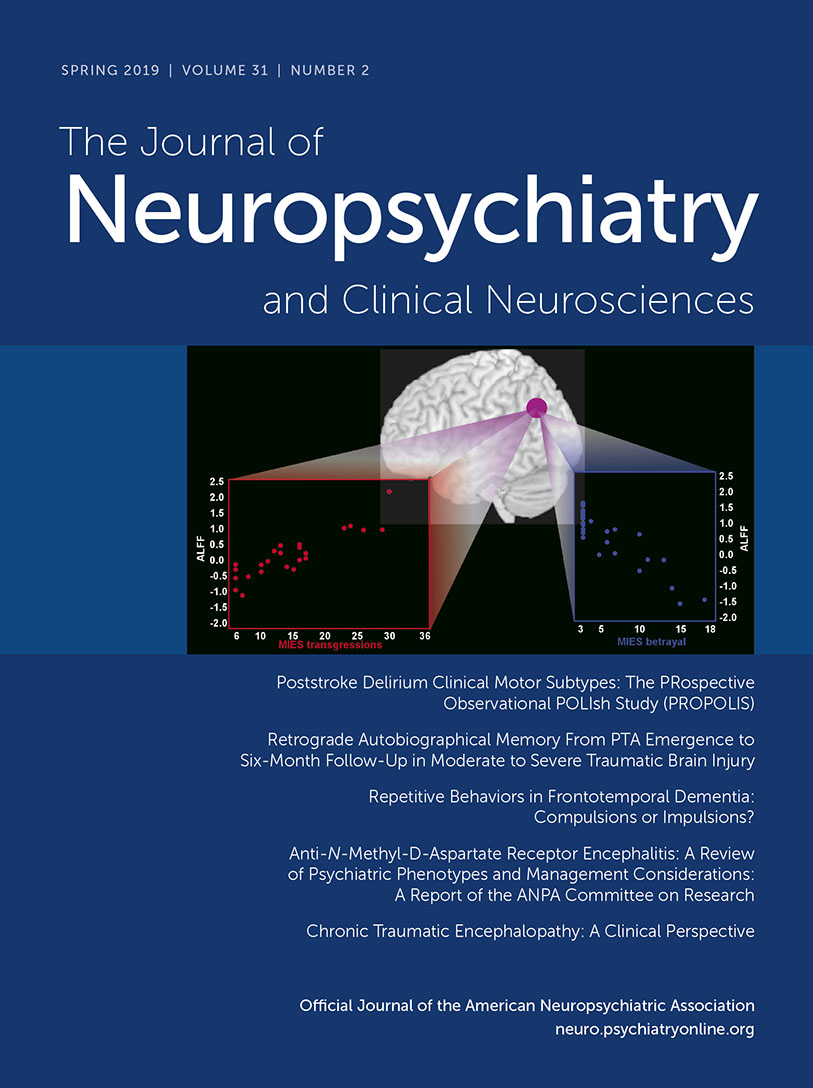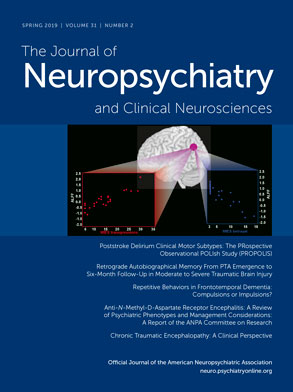To the Editor: Susac’s syndrome is a rare, autoimmune angiopathy of unknown etiology. It is characterized by a clinical triad of branch retinal artery occlusion, encephalopathy, and sensorineural hearing loss and was first described in 1979 (
1). As of 2013, there were only 304 reported cases of Susac’s syndrome worldwide (
2). Of these, 48% of patients presented with cognitive impairment, and 16% presented with emotional disturbance. Despite the prevalence of neurocognitive and psychiatric symptoms, no study, to our knowledge, has investigated long-term outcomes. We present a follow-up to a case report, previously published in the
Journal (
3), of a patient with Susac’s syndrome and long-term history of neurological and psychiatric impairment.
Case Report
A 47-year-old right-handed, single, Caucasian woman with a 28-year history of Susac’s syndrome presented to the neuropsychology clinic as a result of progressive memory problems over the past several months.
The onset of her symptoms occurred over a period of 3 years, beginning at age 19. Initially, she experienced a number of neurological and psychiatric symptoms, including bilateral partial loss of vision, vertigo, and gait disturbances, along with depression, hypomania, and declining cognitive abilities. Neuroimaging around this time revealed prominent cerebellar atrophy. Although her neurological symptoms remained stable, her psychiatric symptoms worsened, eventually leading to two brief hospitalizations. She was given a diagnosis of bipolar II disorder, and her symptoms were eventually managed with low dosages of aripiprazole and sertraline.
The patient’s symptoms remained relatively stable until new and worsening symptoms began to emerge over a 2-year period, beginning at age 32. At this time, she reported increased unsteadiness, occasional choking on food and liquids, occasional episodes of dysarthric speech, and several instances of halted dysfluent speech. Furthermore, she began to experience episodic confusion and disorientation while driving, which led to an accident involving a collision with a child on a bicycle. Additionally, around this time, she developed an illness, thought to be the flu, that induced vertigo and weaving of gait and led to two falls. A thorough neurological evaluation was completed around this time. Brain MRI revealed characteristic snowball lesions in the corpus callosum, and thus a diagnosis of Susac’s syndrome was given. In the years following her diagnosis, she experienced relative neurocognitive and motor stability, with the exception of an episode of severe depression. At the age of 38, she underwent the previously reported neuropsychological evaluation, described by Assuras and Lacy (
3), which revealed the following findings:
[M]oderate impairments in basic and complex attention, nonverbal learning, and aspects of executive functioning, with language and memory representing significant strengths of the cognitive profile. Emotionally, she endorsed minimal symptoms of depression and anxiety (
3).
At the present evaluation, the patient reported a number of new or worsened symptoms since her previous evaluation. Specifically, she noted difficulty organizing thoughts, frequent confusion, and poor sense of direction, even when driving to familiar places. Emotionally, she reported a recent tendency to become easily irritated. She tended to be self-critical and reported that she often overthinks situations to the point that she is unable to function. She also reported a lack of motivation and loss of a sense of purpose. She noted some impulsivity, hoarding behaviors, and temper outbursts. Furthermore, she reported a persistent sense of paranoia and an inability to distinguish reality from fiction. She denied symptoms of clinical depression on objective measures (Beck Depression Inventory-II). Physically, she remained active and denied any worsening of gait problems. She noted some dizziness, numbness in her hands, headaches, mild swallowing problems, and arm pain. She denied any problems sleeping, changes in hearing, taste, or smell, and new ophthalmological concerns. Results from recent brain MRI remained largely unchanged. She was prescribed aripiprazole and sertraline and became independent in most activities of daily living, although she reported problems driving, cleaning her apartment, and managing her finances and depended on support from her family for many of these activities.
Compared with the previously reported neuropsychological evaluation, results of the present evaluation documented a significant decline in verbal and motor processing speed, attention, and visuospatial judgement, as well as more variability in learning and memory in the context of increased acute anxiety. These findings are consistent with the patient’s subjective complaints of disorganized thinking, confusion, and geographical disorientation.
Discussion
The above case provides an example of long-term neurobehavioral outcomes in Susac’s syndrome. Neurologically, the patient experienced initial partial visual loss in both eyes, vertigo, and gait ataxia. These symptoms have remained relatively stable since their onset. The neurocognitive sequelae is highly dependent on the location and severity of the associated lesion, in this case displaying prominent cerebellar and corpus callosal lesions. In this patient, initial deficits were seen in basic and complex attention, nonverbal learning, and aspects of executive functioning. Follow-up neuropsychological evaluation approximately 9 years later revealed further decline in verbal and motor processing speed, attention, and visuospatial judgement, along with more variability in learning and memory. It is unclear whether the patient’s worsening neurocognitive functioning was secondary to further CNS involvement of Susac’s syndrome. However, in the absence of other risk factors, this may be the most likely explanation. With regard to psychiatric symptoms, the patient initially presented with depression that progressed to include periods of grandiosity and paranoia. She was given a diagnosis of bipolar II disorder. However, her symptoms may be better explained as sequelae of Susac’s syndrome. Taking into account her initial MRI, which revealed cerebellar atrophy, the patient’s psychiatric presentation may be an indication of cerebellar cognitive affective syndrome. These psychiatric symptoms have remained largely stable and well controlled under medication since the initial onset, with occasional depressive episodes and periods of acute anxiety.

